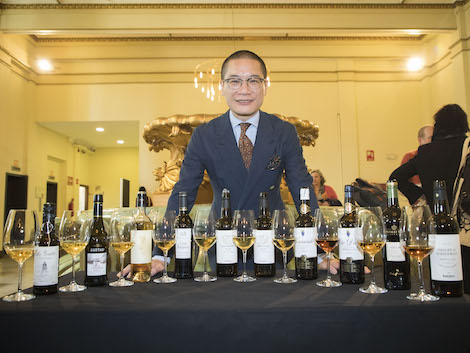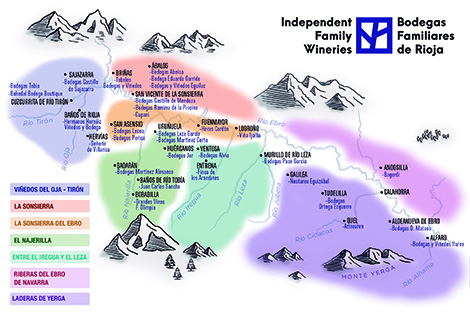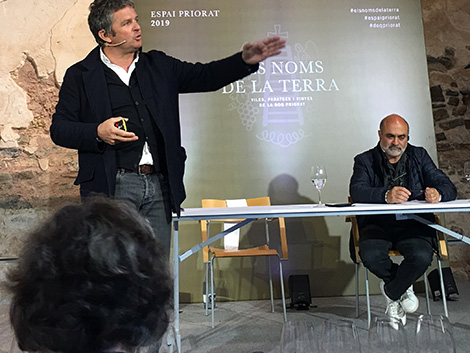Peter Liem: “Sherry is not a wine for everybody and we just have to accept that”

Born and raised in the US, wine writer and critic Peter Liem moved in 2006 to the small and charmingly named village of Dizy in Champagne after working in the wine trade in San Francisco.
Besides Champagne, Liem is rather partial to sherry, a wine he first came across in the 1990s. He co-authored a book called Sherry, Manzanilla & Montilla, alongside Jesús Barquín, and between 2012 and 2017, he organized the very successful Sherry Fest in New York, an event that exposed the wines of this region to consumers and, according to Liem, “expanded the education and awareness of sherry among Americans.
We caught up with him at this year’s International Conference on Traditional Wines from Andalusia held in Madrid where Liem conducted a tasting called “The Terroir of the Bodega”. Now that the Sherry Fest is no longer being held, Liem thinks that exporting an event on Andalusian Wines to New York City “would make a lot sense”.
How did you get into sherry?
I got in the wine trade straight after university in the 1990s and I became a wine retailer and sommelier in the US. I had the opportunity to taste sherry and I was immediately struck by how different it was to any other wine in the world. That made me want to learn more.
When was your first trip to the region?
I went to Jerez in 1998 for the first time and, as you know, once you visit the region you become hooked for life.
It’s very important to go to Andalusia to understand the wine. You can say that about any part of the world, but I really think that it is specially true with sherry. You have to come to the Marco de Jerez, you have to taste the wines, visit bodegas, talk to people, see the vineyards. I did that and I was immediately hooked. For the next 20 years sherry has always been something that I’ve loved to drink.
Do you often travel to the region?
I do. Since that initial voyage I’ve made many trips to the region. Since about 2005-2006, I’ve gone every year. I wrote my book on sherry in 2012 so prior to that I spent a lot of time in the region, researching and tasting a great deal.
Are you planning to do a new edition or revision of your book?
Not of that book specifically, but there’s a group of us —of which I’m a small part— doing a book project in Spanish that will be released soon.
Can you tell us a bit more about this new book?
I don’t really know enough, but I can tell you it’s all about sherry.
Vizetelly, Allen, Busby, Julian Jeffs or André Simon. There was a lot of literature in the past, but not so much now. Why is that?
I think sherry just fell out of favour in the wine world and became a very specialized thing. Before our book, the last brand new English language book written about sherry was in 1988 by Jan Read. Julian Jeffs’ book was updated but it’s not a new book so ours was the first in 20 years. I think there is more room for it now; there is potential for something more to be written.
What changes, good and bad, have you seen in the Sherry Triangle since your first visit?
The region has changed dramatically and I think it’s been largely for the good although you can always talk about economic problems when it comes to the sherry industry.
Sales are shrinking and yet paradoxically interest in sherry as a fine wine is greater than it’s ever been in our lifetime, and maybe in the last century. You have this niche of the best sherries, that are increasing in price and popularity around the world, but those still represent a minority proportion of the market. Some firms are still going out of business —most notably, in recent times, Pedro Romero. It was an iconic name in Sanlúcar, and yet it went bankrupt and that is really sad.
On the positive side, there is more energy because there is an interest in sherry as a fine wine in export markets —not so much in Spain. Because of that interest, producers here are working harder and making better wine; there is more interest in the vineyards, in the idea of terroir in a vineyard sense, not on a bodega sense.
Can you draw any parallels with Champagne?
I primarily work with Champagne; it’s my day job and live there. And yes, you can draw a lot of parallels between champagne and sherry but one of them is that up until the 1960 or 1970s there was a lot of talk about the terroir of the vineyards in Champagne. You look at old literature and is all about this. And then everything changed in the late part of the 20th century; people in Champagne began to talk about process and I think the exact same thing happened in Sherry country.
If you look at old books, pre 1960s, people in the Sherry Triangle talked about the pagos, the differences between Macharnudo and Balbaína —there was a lot more of this discussion. And then it all vanished around 1970 and people began to talk about sherry exclusively as a process. There’s been a change in attitudes over the past 10-15 years. We are treating sherry as a real wine now and I think that’s very important.
Did they forget about the vineyard and terroir because sales were buoyant?
That happened in Champagne. There was a focus on marketing, on selling by brand and it was very successful. Champagne sales exploded but in the Sherry Triangle it was a little different. Maybe it is linked to Rumasa and to sherry becoming famous as a cheap, bulk wine, which was not a good thing. The image is changing again because nobody is interested in sherry as a bulk wine; that audience is literally dying. So there are still bodegas that are going to go out of business for this reason but sherry as a fine wine is stronger than ever. I think in the future sherry will be a much smaller producing region but the quality will be much higher.
Is this something that producers here want to hear?
The good ones do. It is hard to predict the future but I think there is a real interest to improve quality among high-end producers who are interested in making the best wines they can. I think the signs are very encouraging.
As demand for less alcoholic, lighter wines increases, how can sherry play its cards?
I don’t think it’s necessarily an issue of changing the style of the wine but focusing on quality and authenticity. In recent years the market for En Rama sherry has exploded. En Rama represents wine as it should be and people are realizing that the heavily filtered style of sherry is actually artificial. So when you have a story like En Rama and present the wine as it is, wine consumers really respond to it because it’s a matter of quality and authenticity and people want to learn more.
In export markets you see bodegas that are very successful like Valdespino, Tradición or Fernando de Castilla. They are focusing on high quality wines with no unnecessary manipulation and present their wines as something very authentic and as one of the world’s great wines. That’s what wine consumers are looking for. You don’t have to fit into a certain style. Sherry lovers, the inner circle, know that sherry is a great wine and sherry just has to keep being great.
Sherry seems to be fashionable among wine professionals but it is widely ignored by the general public. Do you think this has to do with education?
Education is always important but also the profile of sherry doesn’t really fit into contemporary tastes. Sherry is a very particular wine, it’s not all about fruit, it’s relatively high in alcohol, it’s either aged under flor or it’s aged oxidatively… it’s not your average Chardonnay.
Sherry is not a wine for everybody and I think we just have to accept that. The market is necessarily small; the people who really, really love sherry are hooked for life but in the foreseeable future that’s going to represent a distinct minority of the wine drinking population. Who knows? Maybe some day we get to 19th century levels, but not in our lifetime.
Is sherry meant to be a wine for connoisseurs?
I think so. You can make a lot of it because of the solera system, but of course the best wines, because they age for so long, they exist in limited quantities and that’s OK because it is a wine for connoisseurs; it’s a niche market. It’s never going to be a wine that’s going to please everybody but the best wines and the oldest wines are going to attract a larger audience and are going to go up in price. In may cases, they have already been acknowledged as being among the best wines in the world.
What do you think of the new wave of small young producers in the Sherry Triangle?
It’s fantastic and they have brought great energy to the region. Even the appearance of new names is something that wouldn’t have happened 10-20 years ago and that is really positive for the region. It’s an injection of new ideas that is moving the appellation forward.
In recent times, there’s a move among some small producers towards the vineyard and to make unfortified wines. What do you think of these wines?
It’s very interesting and it will be fascinating to see how it develops. We have already seen some fantastic wines by people like Willy Pérez and Ramiro Ibáñez. What they are doing is very exciting and I think that’s only going to increase. There will be more people doing it and we’ll gain a better understanding of the vineyard in the Marco de Jerez. And these wines will help to bring some cash, which doesn’t hurt.
Do you think these wines could or should become the basis of the pyramid of quality?
It makes a lot of sense because these wines have a lot of character and you don’t have to age them as long. Already we’re seeing some sherry bodegas experimenting with this sort of wines —take Valdespino or Hidalgo La-Gitana— and they are being successful. So I think, why not?
Is there a risk that the region may be heading for a split between vineyard-focused producers vs bodega-focused producers or large vs small producers?
Large versus small is a big debate in the world of wine. Consumers tend to think small family-owned is good, and large is bad, corporate, industrial. I think sherry is quite different to other wines in that regard. Here, bigger is almost better. The large bodegas have the capital to do a lot of things including having more complex soleras. With the solera system you can make high quality wines in large quantities without sacrificing the quality.
The quality in producers like Gonzalez Byass is amazingly high and I think their scale allows them to get into really interesting projects. Antonio Flores is always experimenting with something new and he has the resources to do it. At Grupo Estévez, Eduardo Ojeda is the same. He’s in charge of a lot of wines but he is also involved in small projects and that’s quite exciting and innovative.
With reputation of Consejos Reguladores down and bodegas leaving appellations, how do you see Jerez’s?
I think the Consejo is a fantastic organization; their stewardship of the sherry region is unlike any other body I can think of in the wine world. Perhaps the CAVC in Champagne, but sherry is a smaller industry. Maybe because sherry has been so marginalized for so long, people stuck together a little bit more, there’s more solidarity in the region. The Consejo does fantastic things to promote sherry and to increase the quality within the industry.
Is there anything that the Consejo could do better?
I know the Consejo is working very hard. Sherry is unlike Cava or other wine regions. A lot of the resistance to Cava stems from the fact that people feel that the name is diluted and now stands for bulk wine instead of quality and they want to break away from the appellation.
Some people in the Sherry area say 'we don’t want to use the word sherry; we’d rather say Vino de Jerez' or make up a new term and that’s fine but I don’t think that problem is as important as in Cava country. OK, there is bulk sherry but that market is dying. If you talk to young Americans, Canadians or Scandinavians they don’t have negative connotations of sherry like the old generation did. People don’t think straight away that sherry is bad.
Of course there are disagreements, but I think the Consejo is able to present a much more coherent picture of the sherry region than perhaps their counterparts in other regions.
You are in favour of adding bottling dates to sherry. Do you think that’s something the Consejo should encourage?
I like that, although I understand the argument that it might look like a sell-by date. But again, that’s education. In Champagne we have the same discussion and division about disgorgement dates. Some producers have got around it by putting a QR code and this is an elegant solution and has worked well in Champagne. If you know how to read the code you know when it was bottled.
I think having a code is perfect because the people that would be afraid by the bottling date don’t know how to read the code and will ignore it and those who do are able to access it.
Do you think there is room for cooperation between Jerez and Champagne?
There are a lot of parallels but they exist in different scales. Champagne is much larger and is more renowned in the world. I know a lot producers in Champagne who like to taste sherry and everyone in the Sherry Triangle likes to taste champagne. There has been a little bit of collaboration although I’d like to see more but I’m not sure what that would look like.
Maybe a big tasting of sherry and champagne? Would you be willing to take part in something like that?
Maybe. I’ve done some things on a small scale but it would be interesting to organize something on a large scale.
David Léclapart is now making wines in Sanlúcar. Have you tried his wines? What can a Champagne producer bring to the area?
I have tried them and his wines are very interesting. I’m vey glad that he’s doing them although stylistically they are a little too natural for me. I’m not a big fan of natural wine. I’m sensitive to oxidation and volatile acidity but I think the wines are fascinating and I would like to taste more. It’s a great project and I want to follow it.
Montilla seems to live in the shadow of Jerez. How can the region improve its image?
It’s true that we often talk about Montilla only in the context of Jerez and it’s been difficult for them to find their own identity. I don’t know how they can change that. In export markets it seems as if they are all lumped together. Most Americans just call Montilla sherry or it goes on the restaurant list under sherry. For now, I don’t think it’s such a bad thing but of course they are different appellations and eventually Montilla will have to find an identity of its own and that’s going to be a slow and long process.

Yolanda Ortiz de Arri
A journalist with over 25 years' experience in national and international media. WSET3, wine educator and translator
NEWSLETTER
Join our community of Spanish wine lovers






